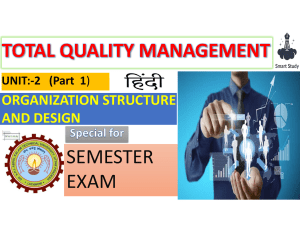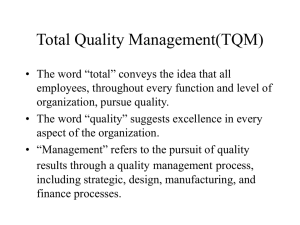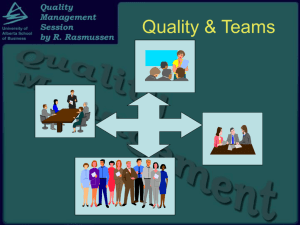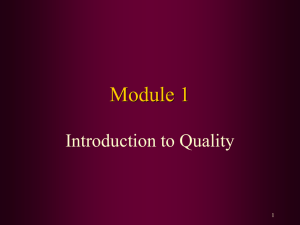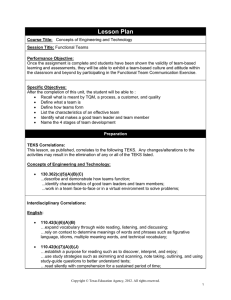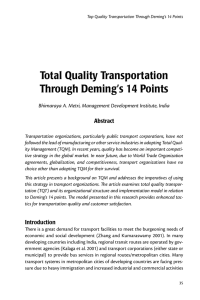Eight Principles of TQM: Customer Focus
advertisement
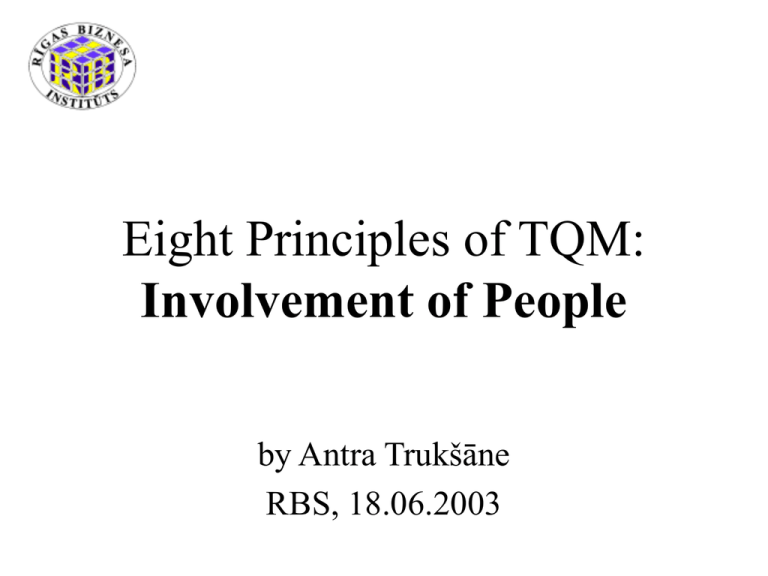
Eight Principles of TQM: Involvement of People by Antra Trukšāne RBS, 18.06.2003 “People at all levels are the essence of an organization and their full involvement enables their abilities to be used for the organization’s benefit.” (Principle Involvement of People, “Quality Management Principles and Guidelines for their Application”) “Most managers would agree that the effectiveness of their organizations would be at least doubled if they could discover how to tap the unrealized potential present in their human resources.” (Douglas McGregor) “The greater waste in America is failure to use the abilities of people.” (W.Edwards Deming) The total quality management approach offers a substantial potential for improvement if accompanied by an appropriate human resources effort. It is becoming a maxim of good management that human factors are the most important dimension in quality and productivity improvement. People really do make quality happen Importance of people involvement has been recognized by all the nowadays popular quality management and business models: The European Excellence Model: Enablers (or Approach) People Leadership Policy and Strategy Partnerships and Resources Results People Results Processes Customer Results Society Results Innovation and Learning Key Performance Results What’s behind the People part of the EFQM Excellence model: • People cover the following five criterion parts that should be addressed: – 3a. How people resources are planned, managed and improved – 3b How people’s knowledge and competencies are identified, developed and sustained – 3c How people are involved and empowered – 3d How people and the organisation have a dialogue – 3e How people are rewarded, recognised and cared for The Malcolm Baldrige Model in the U.S. • People cover the following criterion parts that should be addressed: – How the company enables employees to develop and utilize their full potential, alligned with the company’s objectives – What are the company’s efforts to build and maintain a work environment and work climate conductive to performance excellence, full participation, and personal and organizational growth – Subcategories include work systems, employee education, training, and development, as well as employee well-being and satisfaction ISO 9001:2000 approach with regards to people is limited to: • Clear definition of responsibilities and authorities • Competence required to accomplish the tasks given and training required to ensure the minimum competence level stated • Very little of communication (top – down mainly) • Very little of work environment (focus on products rather than people) Some HR approaches are in place in every organization. What are the main pitfalls then? • Lack of clear communication regarding people’s responsibilities, but especially authorities and accountabilities • Responsibilities and authorities not balanced • People made accountable for and dependant on things that they have no or little influence on. Pay poorly related with the individual’s performance • Lack of empowerment. Too centralized decision making Some HR approaches are in place in every organization. What are the main pitfalls then? • Poorly established communication regarding what’s going on and what are the results achieved • Lack of consistency in HR related activities (suggestion schemes, climate surveys etc.). Slogans that are controversial to daily practices • Lack of training, or often overestimation of the importance of technical training Recall W.Edwards Deming’s 14 Points for Transformation: • Institute training on the job • Break down barriers between departments to build teamwork • Drive fear out in the workplace • Eliminate quotas on the shop floor • Create conditions that allow employees to have pride in their workmanship and abolish annual reviews and merit ratings • Institute a program of education and self-improvement 14 Points for Management #8 Drive out fear No one can put in his best performance unless he feels secure (it means without fear, not afraid to express ideas, not afraid to ask questions). Management by numbers is also a form of management by fear. Fear definitely influences financial performance of the company: every “red bead” has a name on it, employees know the names, but they often do not tell, because they are afraid. 14 Points for Management #9 Break down barriers between staff areas Organizations manage people and work through functional departments. The manager and people within these departments are dedicated to their own objectives that are usually divisive. Departments are competing, rather than collaborating, with each other. The traditional system creates “departmental fortresses” – barriers to communication across the organization, but teamwork is sorely needed throughout the company. It allows to compensate one’s weakness with someone else’s strength, but it’s a risky business if annual ratings are important. Ratings defeat teamwork. 14 Points for Management #10 Eliminate slogans and exhortations Posters and slogans never helped anyone to do a better job, as they are directed at the wrong people. They arise from management’s supposition that the production workers could, by putting their backs into the job, accomplish zero defects, improve quality, productivity and all else that is desirable. Management must stop requesting productivity without providing such methods to achieve it. 14 Points for Management #11 Eliminate targets for the work force. Substitute leadership By elimination of numerical quotas for the work force are meant quotas like “to handle certain amount of phone calls per hour”, “sort 15,000 pieces of mail per day” etc. The argument for it is that rates for production are often set to accommodate the average worker. Naturally, half of them are above average, and half below. What happens is that peer pressure holds the upper part to the rate, no more, but people below the average can not make the rate. The result is loss, dissatisfaction, and turnover. 14 Points for Management Internal goals set in the management of a company, without a method, are also useless. The argument is that in a stable system there is no use to specify a goal. You will get whatever the system will deliver. A goal beyond the capability of the system will not be reached. If you have not a stable system, then there is again no point in setting a goal. There is no way to know what the system will produce. Management by numerical goal is an attempt to manage without knowledge of what to do, and in fact is usually management by fear. 14 Points for Management #12 Remove barriers that rob people of pride of workmanship These barriers must be removed from two groups of people: management or people on salary, where the barrier is the annual rating of performance, and hourly workers, where are many barriers like: being under pressure to meet a daily quota of numbers, not quality, having no chance to influence the system, not knowing what’s going on. Barriers against realization of pride of workmanship may in fact be one of the most important obstacles to reduction of cost and improvement of quality. 14 Points for Management #13 Encourage education and self-improvement for everyone There is no shortage of good people. Shortage exists at the high levels of knowledge, and tis is true in every field. People require in their careers, more than money, ever-broadening opportunities to add something to society, materially and otherwise. Company has to provide opportunities, but people – care for continual education and selfimprovement (#6 referred to the foundations of training for the management and for new employees). Some important issues to overcome the problems mentioned • People are motivated not only by monetary rewards, but also by involvement in decision making. The people closest to a problem are in the best position to make decisions (or to propose ideas) for improvement. It is equally or even more important in service industries • Decision making and other authorities have to be clearly defined and communicated. Many companies do not pay enough attention to this issue Some important issues to overcome the problems mentioned • No system will work with disinterested or poorly trained people. Training is not always expensive. Importance of on-the-job training is often underestimated. Effectiveness of the training from company perspective has to be assessed • Also increased involvement means more responsibility, which in turn requires a greater level of skill. One area that should be common to most, if not all training programs is problem solving, which is a prerequisite to widespread empowerment • Quality training for management and employees is needed, covering process management, customer focus and other main principles; also leadership training for managers Some important issues to overcome the problems mentioned • It is better to start a few initiatives and consistently implement them than try to grab all at once. Management initiatives started, but quickly forgotten demoralize the workforce. So does inconsistency in requirements Some important issues to overcome the problems mentioned • Performance appraisal may be the Achilles’ heel of TQM because neither performance appraisal supporters nor TQM gurus have invented a methodology for completely installing performance appraisal that meets TQM requirements: – Old measurement, reward and appraisal systems do not work for TQM. Deming states that individual performance evaluations encourage short term goals, undermine teamwork and call for competition among people for the same rewards. Should individual performance appraisals be eliminated, as Deming suggests? – The integration of total quality and performance appraisal is necessary, alligned with the principle of shared responsibility for quality, but how? Some ideas on principles for modification of the existing performance appraisal systems • Customer expectations, not the job description, generate the individual’s job expectation • Results expectations meet different criteria than management-by-objectives statements • Performance expectations include behavioral skills that make the real difference in achieving quality performance and total customer satisfaction • Employees are active participants in the process Some important issues to overcome the problems mentioned • Compensation systems should also be reviewed to support TQM. Historically, compensation systems have been based on: – Pay for performance – Pay for responsibility (a job description) Each of these is based on individual performance, which creates a competitive atmosphere among employees. In contrast, the TQM philosophy emphasizes flexibility, lateral communication, group effectiveness, and responsibility for an entire process • Individual or team compensation? Gain sharing, profit sharing, and stock ownership are among the systems designed to create a financial incentive for employees to be involved in performance improvement... Some important issues to overcome the problems mentioned • HR department should play a critical role in the implementation of a holistic quality environment in support of a strategic quality initiative. To accomplish this role: – HR initiatives should be designed to support TQM philosophy throughout the organization – TQM principles should be followed within the processes of the function itself (quality work the first time, focus on the customer, strategic holistic approach to improvement, mutual respect and teamwork, continuous improvement as a way of life) – Maybe joining the quality and HR functions is a good idea? Finally, some thoughts by some top executives: • “The whole employee involvement process springs from asking your workers the simple question, “What do you think?”” (D.Peterson, Ford) • “The teams at Goodyear are now telling the boss how to run things. And I must say, I’m not doing a half-bad job because of it.” (S.Gault, Goodyear)
